Discovering a leak in your water spa or hot tub can be a frustrating experience, not to mention the costly and time-consuming repairs that usually follow. The good news is that Leak Sealer exists — simple, cost-effective, and always ready to save your day.
Although many hot tub owners are aware of these sealants, I know there can be many questions and doubts when it comes to choosing the right product. That’s why I’m here to help you. In this article, I’ll explain everything you need to know about sealants, including their effectiveness and a step-by-step guide on how to use them properly.
A Brief Guide To Sealants
Put simply, a sealant is a concentrated liquid designed to efficiently plug leaks in spas, hot tubs, and pools. It is formulated with a specific viscosity that allows it to adhere to surfaces effectively when mixed with water.
Once in the water, the sealer reacts chemically with the air or leaks, expanding or forming a flexible coating. When this dries, it forms a long-lasting seal.
Using sealant helps you avoid expensive repairs, it can be used for materials of all kinds. However, note that this temporary solution is not meant to last forever, but it can help reduce or stop water loss until more permanent repairs can be made.
The sealant does not damage the hot tub’s pumps, heaters, chlorine salt generators, or other equipment. But you should take out the filter before pouring the sealant in so it doesn’t accidentally cause the filter to clog.
Do you want to make your hot tub last 3 times longer?
90% of success is in proper hot tub maintenance. To avoid (or prevent further) leaks, you should follow the hot tub care schedule and use the proper chemicals.
We know how it may seem confusing; that’s why our team has created a complete hot tub care guide and we reveal the tricks that the manufacturers would like to keep secret.
What Can Cause Leaks Anyway?
Leaks can happen for all sorts of reasons — whether it’s due to regular wear and tear, harsh chemicals, or even a little too much pressure.
Similar to when someone drops their phone, and it gets a crack, a hot tub can develop cracks too. Pipes, fittings, and joints might get little fractures, especially if they go through temperature changes or stress due to changes in pressure.
Sometimes the fault lies with the manufacturer, as poor workmanship during the initial installation of the plumbing system can result in improper connections, leading to leaks over time.
Keeping an eye out for signs of leaks and fixing them early can save you from bigger headaches down the line. A leak sealer can help in 80% of small leak cases, but if you’re not sure what’s causing the leak, calling in a pro is always a good idea!
What Kind of Leakage Can Be Stopped by Sealant?
While sealant might not be a magical fix for every issue, it’s a great solution when it comes to dealing with small leaks. It’s a quick and easy way to address minor leaks before they have a chance to turn into major problems.
But even such a tool has its limitations, so let’s take a look at the sealer’s best and not-so-best uses.
Appropriate uses:
- Ideal for all varieties of spas, hot tubs, and pools.
- Effective for addressing leaks in walls, floors, housing, return lines, suction lines, skimmers, fittings, and more.
- Recommended for water loss in hot tubs that are less than 3 mm per day.
- Suitable for pools experiencing water loss of less than 5 cm or 50 mm per day.
- Compatible with hot tubs with salt levels of up to 3000 ppm.
Inappropriate uses:
- Not suitable for environments with fish or other living organisms.
- Not recommended for addressing water loss exceeding 3 mm per day in spas or hot tubs.
What Is the Best Hot Tub Leak Sealer?
My team conducted a thorough analysis of leak sealant products designed for hot tubs, spas, and pools. We compared various high-rated sealants available on marketplaces, considering factors like application ease, drying time, and long-term effectiveness to achieve the best results. After weighing positive and critical reviews, we even tested the best product ourselves.
Now we confidently present two best leak sealants that have demonstrated effectiveness, garnered positive user feedback, and aligned with the needs of hot tub owners. The most effective products turned out to be Marlig Leak Sealer and Spa Choice Seal a Leak. Most of the reviews were positive, although there are people who used the sealant in the wrong way or just the crack was too big for this type of sealant.
Below, you can read more detailed reviews on both products.
Marlig Leak Sealer
Pros
- Provides a rapid solution for addressing minor leaks in swimming pools, hot tubs, or spas.
- Designed to dissolve over time and with exposure to water, preventing long-term maintenance issues.
- Formulated to be non-corrosive, ensuring it won’t harm pool or spa equipment.
Cons
- Consider getting a larger package in advance, as 8-ounce content is used in a single application.
- It is effective mainly for addressing small cracks or gaps, and may not be suitable for larger or more significant plumbing issues.
Marlig Leak Sealer is a good way to quickly deal with small leaks in your swimming pool, hot tub, or spa. It’s super easy to use, and you won’t need any professional help to apply it. Plus, it works on all pool and spa surfaces, so it’s pretty versatile.
However, it’s a temporary solution for minor leaks, providing time for more permanent repairs to be planned or carried out. Also, it’s not very effective for larger leaks or plumbing issues that are more serious.
Designed to dissolve over time and with exposure to water, preventing long-term maintenance issues, you might need to reapply it if the leak persists or worsens.
“This product is amazing, seriously! My hot tub is like 19 years old and has been leaking from like a bunch of different spots for a while now. It was so bad that the stone pad was always wet, and I had to refill it every couple of days. I tried everything, but nothing worked. But then, I found this product, and it sealed all the holes in less than 30 hours with zero signs of dripping! This is the single best investment you can make to benefit your hot tub if it’s leaking. It works!”
– Colton P, from the US
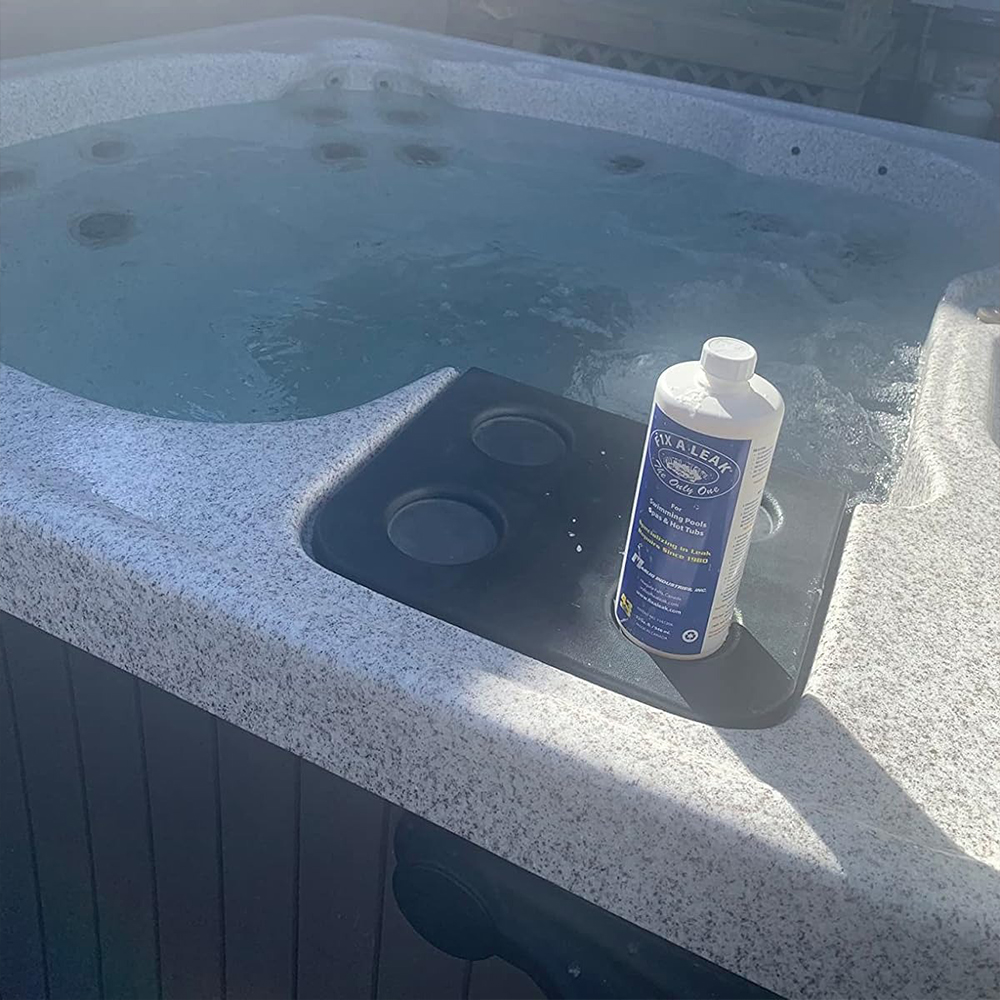
Spa Choice Seal a Leak
Pros
- Aimed at direct application near the leakage point but also works when applied directly in the skimmer.
- The standard 16 oz. of product per package makes it a cost-effective solution in the long run.
- Great not only for fixing the leakage but also as a preventive option.
Cons
- There’s a common theme of confusion and uncertainty regarding the instructions for application, particularly about the circulating pump and main pump.
- Works better when gradually applied, which means you need some patience to observe the product’s impact.
Spa Choice Seal a Leak is an affordable and generally effective solution for addressing leaks in hot tubs. Compared to Marlig Leak Sealer, which contains 8 oz. per package, Spa Choice doubles the amount, giving you 16 oz. of the product per package, making it more convenient to store.
Many users have reported success in stopping leaks, and the product is versatile and suitable for various types of spas, hot tubs, and pools. However, there are concerns about potentially confusing instructions and uncertainties in the application process.
Unlike Marlig Leak Sealer, the manufacturer suggests pouring the sealer directly into the water at the area of the leak. But if you’re not sure where it’s coming from, you can still pour it in a skimmer.
You need to be patient and experiment with the dosage for optimal results, gradually adding a few ounces every 24–36 hours. There is also a possibility of the leak coming back after a few months, but despite these cons, the product is a cost-effective and simple alternative to more extensive repairs and draining.
“So far so good… My 21-year-old hot tub started a small leak last year. It’s been leaking 5 to 6 gallons every 2 or 3 days. My guy at Easyspa recommended a sealer that worked for a year. But it cost twice as much, plus, I had to circulate it for a week, drain it, and let it dry for a week, which meant no relaxing in the spa for 2 weeks! So I tried this product and 2 oz stopped my leak. Time will tell if it works…BUT… no 2 weeks, no draining, drying, etc. All I had to do was pour 2 oz into the filter area, run pumps for 6 to 8 hours, reinstall filters the next day, and dry after 5 days. Will buy again if needed.”
– Mr. William D. Kern Jr., from the US
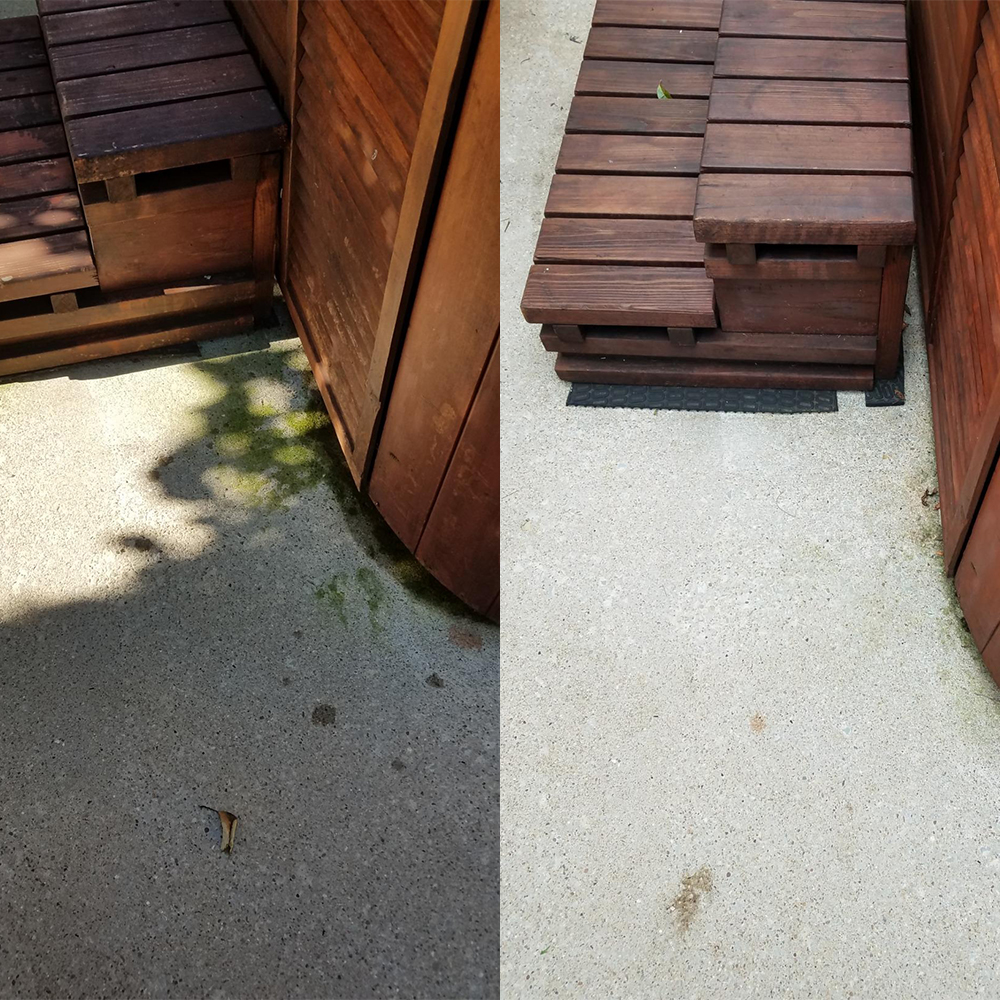
How To Use a Leak Sealer: Step-By-Step Instructions
Let’s follow these simple, step-by-step instructions to fix the leak and get your hot tub running again in no time.
Step 1. Identify and Fix Water Loss Within 24 Hours
The first thing you need to do is to identify and fix the water loss within 24 hours. You don’t need to know the source of the leak, just fill the spa and mark the water level with tape or anything handy.
After 24 hours, check and fix the new water level. Leave marks until the end of the repair. This will help you monitor the results.
Step 2. Calculate the Amount of the Sealant Required
Depending on the size of your hot tub, you may need a different amount of sealant. Hot tubs use 4 oz. (120 ml.) for each 250 gallons (950 liters) of water.
So, on average:
- A hot tub for 2 people (200 gallons) requires 3.2 oz.
- A hot tub for 4 people (300 gallons) requires 4.8 oz.
- A hot tub for 6 people (350 gallons) requires 5.6 oz.
(We use average volumes of hot tubs. Your hot tub may vary).
Also, note that it may be necessary to re-apply the sealant and possibly increase the amount. So it’s best you purchase the larger sealant bottle.
Step 3. Remove All Cartridges or Filtering Devices
Ensuring a successful leak repair involves preventing the sealant from interfering with your hot tub’s filtration system.
By eliminating potential barriers in the form of filters, you set the stage for the sealant to circulate effectively and target the areas needing repair.
- Remove filters: Take out all filter cartridges or any other filtering devices your hot tub uses. This step is crucial to prevent these components from unintentionally sealing during the process.
- Empty filter tank: Allow water to circulate through the now-empty filter tank. This ensures that the sealant can freely move through the hot tub without encountering any obstruction from the filtration system.
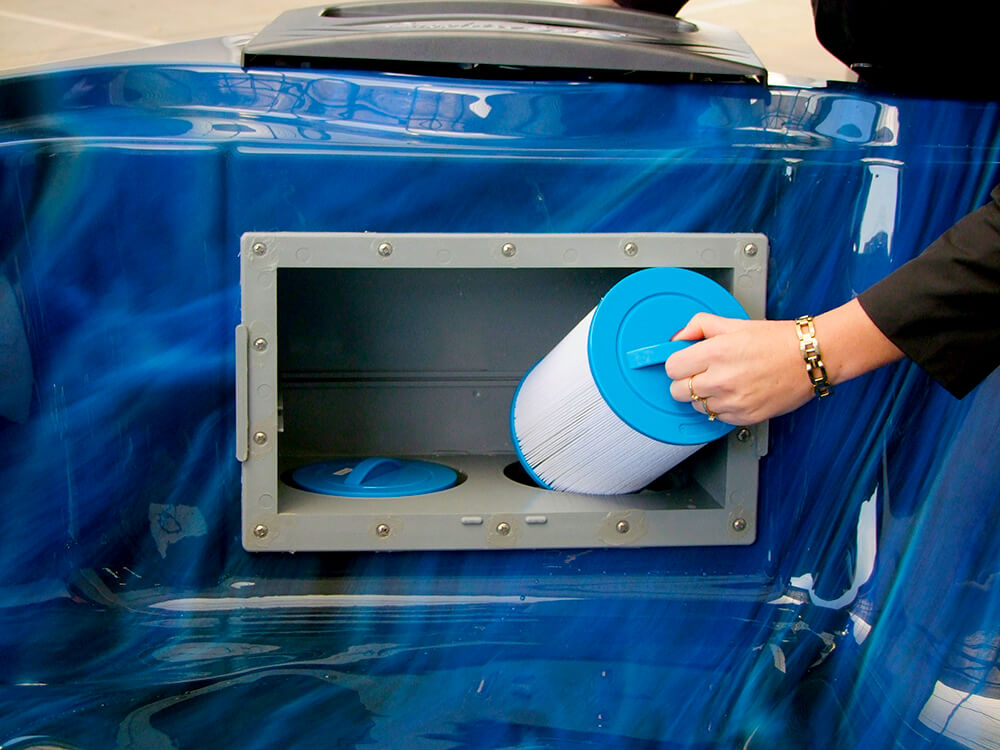
Step 4. Turn on the Pump
The concentrate should be added directly to the water.
Although the seal will work regardless of the water temperature, for best results the temperature should not be below 70° F. From my observations, the seal works best at water temperatures above 100° F.
Step 5. Shake the Sealer and Slowly Add to the Water
Before use, shake the suspension vigorously. Then slowly add the seal through the skimmer or any suction port.
Step 6. Recirculate Water for 6–8 Hours

The seal is very heavy, so it sinks to the bottom. So, in addition to pump recirculation, you can help the sealant rise from the bottom by stirring (sweeping) it with a soft broom.
Recirculate and clean the hot tub floor until the leak stops. Then turn off the system.
Step 7. Check the Water Level the Next Day
Check carefully for water loss. Make new measurements and compare the results with the previous ones. Your leakage could have stopped completely, partially, or not at all.
- If the hot tub has stopped leaking, you can proceed to Step 8.
- In case the leak has slowed down, but not stopped completely, repeat all the previous 6 steps.
- However, if the leak persists, you can try increasing the product quantity and repeat the treatment. If the leak still doesn’t stop after several attempts, it’s likely to be too large or in a place where the sealant can’t reach. In that case, it’s best to contact the professionals.
Step 8. Do Not Restore Normal Water Circulation for 2 to 4 Days
The sealant must dry and solidify to form a strong, long-lasting seal.
Step 9. Reinstall the Filter and Clean the Cartridges for Several Days
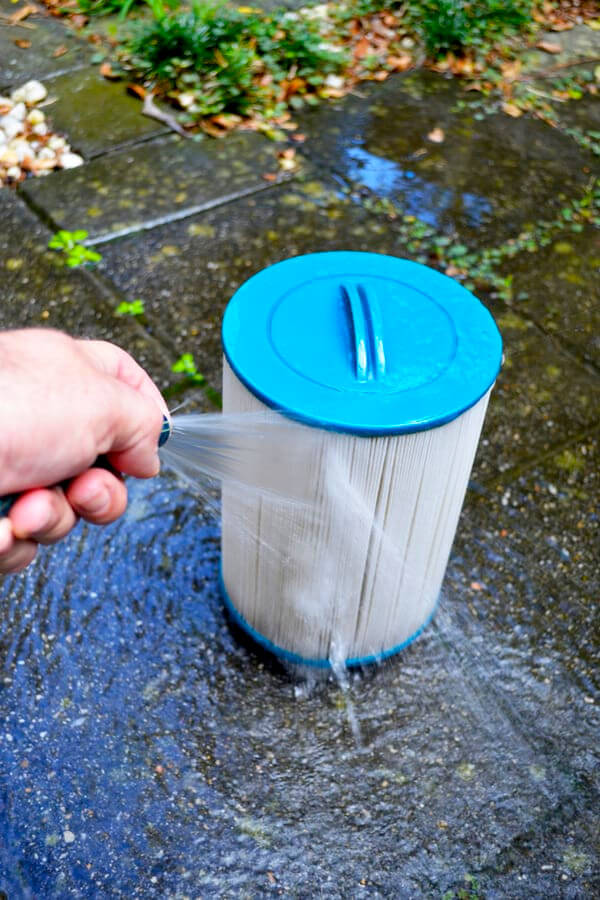
There’s no need to drain the water. The sealant does not affect the chemistry of the water, and excess product will be eliminated with the restoration of normal filtration.
Reinstall the filter and resume filtering. Note that the filter cartridge used to remove excess sealant must be cleaned several times until the sealant is completely removed. Do not allow the cartridge to dry until it is spotless.
Step 10. You Can Enjoy Your Hot Tub Again
Bathing can resume after the filter has been used to remove the excess sealant and the chemistry is optimized.
Depending on the size of the leak, it might take several tries to seal it. But when the leak is sealed, it’s usually a permanent fix.
However, leaks in pipe cracks or volumetric joints may be subject to vibration or pressure expansion and so might not be permanently sealed. Some leaks, because of their location, size, or water loss, may need repairs by a qualified technician.
But fixing leaks with a seal is worth trying. This method takes little effort and money and can be an effective solution.
How To Prevent Leaks in the Future
The elimination of leakages when they first start, along with some preventative measures, greatly increases the chances of a simple and successful repair. You should take the following precautions:
- Keep a regular eye on water leaks
Whenever you change the water, open the cabinet and look at all connections, checking whether they are dry. - Pay close attention to the pump
Check the pump for signs of water (water spots or rust). - Keep the water properly balanced and clean
Low pH and high bromine/chlorine content can cause leakage over time.
You can use strips or digital meters to check the pH of the water. - Minimize the amount of vibration.
You can minimize the amount of vibration by placing your hot tub on thick rubber.
Summary
Leak sealer products are a reliable and cost-effective solution that can save you from unnecessary stress, wasted time, and unnecessary expenses. In fact, sealants work effectively in almost 80% of cases, which makes them an excellent first option to try.
Even if you’re unable to detect the source of the leak, rest assured that sealants are your best bet. We selected two best sealers that can help — Marlig Leak Sealer and Spa Choice Seal a Leak.
Sealants are great for fixing tiny leaks and inconveniences, but in the case of significant leaks and cracks, you should consider seeking professional help.
FAQ
🤔 Where Can the Sealant Be Used?
Small leak sealants are suitable for all types of spas, hot tubs, and pools. They work equally well with different materials. However, it’s important to note that sealants must not be used in bodies of water that have fish or other living creatures as it can harm them.
🏆 What Is the Best Hot Tub Leak Sealer?
Our team tested and reviewed the best high-ranked available sealants and ranked them based on their effectiveness and safety. The most efficient products we found were the Marlig Leak Sealer and the Spa Choice Seal a Leak.
💪 Is a Sealant a Durable Solution?
The durability of the sealant depends on the size and severity of the leak. While it can take several attempts to seal the leak, a successful seal is usually permanent.
However, leaks in pipe cracks or volumetric joints may be subject to vibration or pressure expansion, and therefore, may not be sealed permanently. Also, due to location, size, or water loss, some leaks may need to be repaired by a qualified technician.
⏳ How Long After Using the Sealant Can I Use the Hot Tub Again?
To ensure a strong and long-lasting seal, you should not restore normal water circulation for 2 to 4 days. During this time, the sealant must dry and solidify. Once this has happened, you can resume bathing after running the filter to remove any excess sealant and optimize the chemistry of the water.
💦 Do I Need To Drain the Water After Using the Sealant?
No, you don’t need to drain the water. The sealant doesn’t affect the chemistry of the water, and any excess product will be eliminated with the restoration of normal filtration.
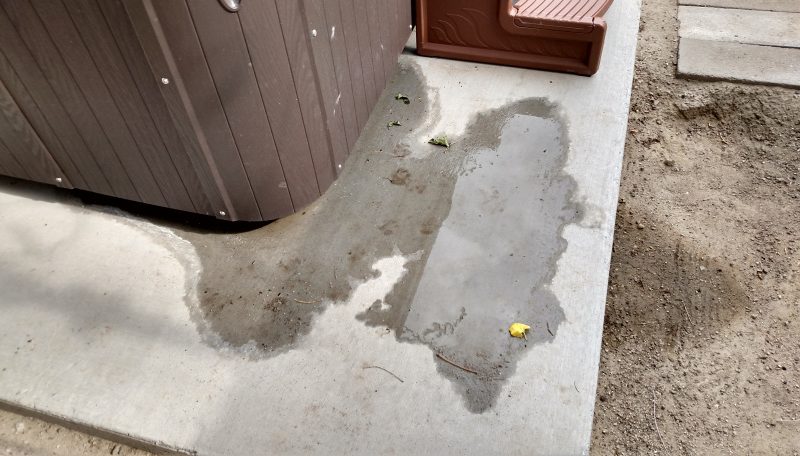
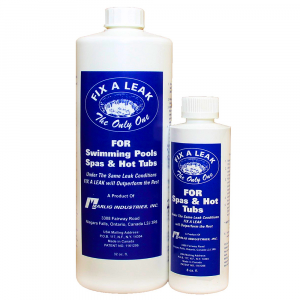
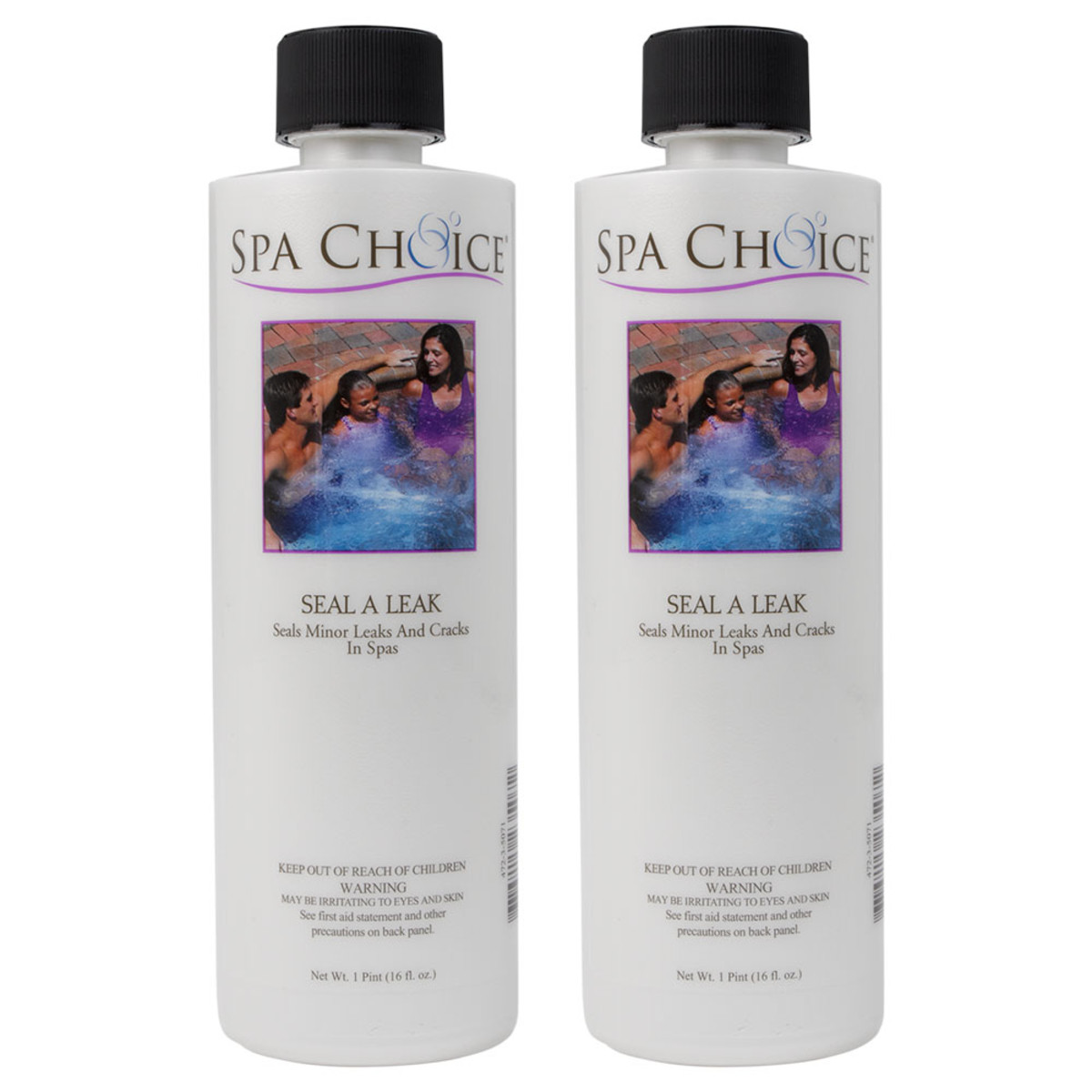

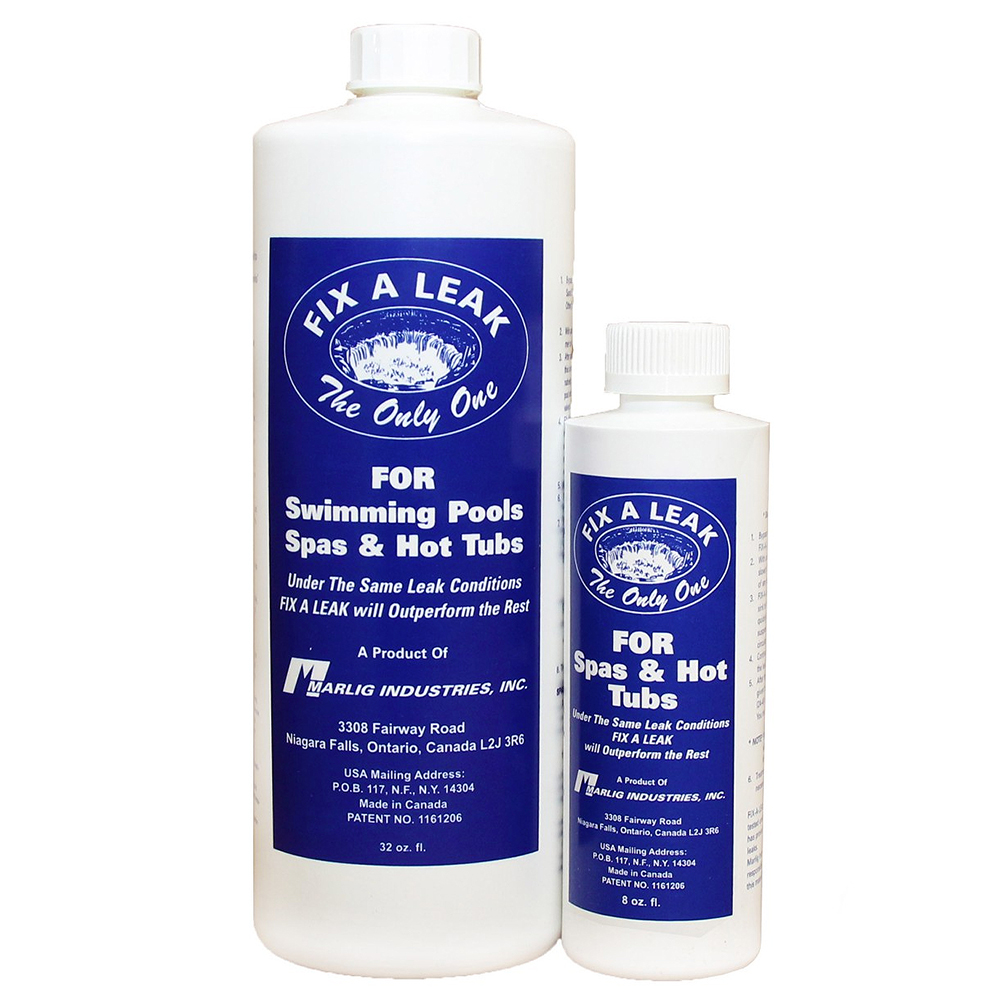

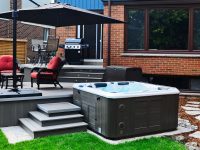


This post made an interesting point that when looking to have our hot tub resurfaced or repaired, it is important to hire a professional. It makes sense for us to hire a professional as they are certified and experienced. I will definitely keep this information in mind when I look for a contractor.
Will it seal leaks in a rock/mortar hot tub?
Does it need to be empty after application for it to dry?
1. Unfortunately, not. Rock/mortar hot tubs are made from solid materials for which leak sealer is unsuitable.
2. No, you shouldn’t drain your hot tub, since the leak sealer will dry under the water.